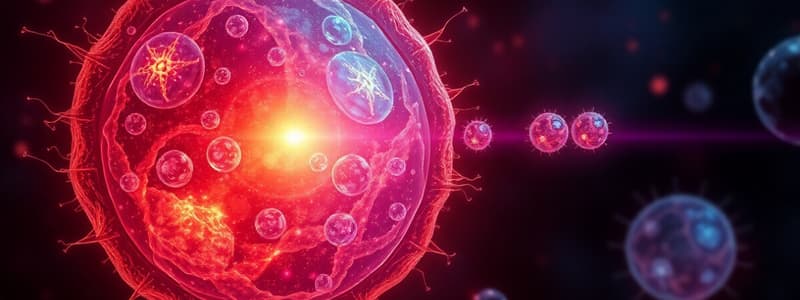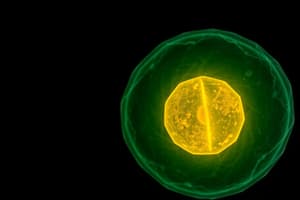Podcast
Questions and Answers
What is the main purpose of meiosis?
What is the main purpose of meiosis?
- To replicate DNA without reducing chromosome numbers
- To increase the number of chromosomes in a cell
- To produce cells with a reduced chromosome number (correct)
- To create identical copies of the original cell
During which phase of meiosis does crossing over occur?
During which phase of meiosis does crossing over occur?
- Telophase II
- Prophase II
- Metaphase I
- Prophase I (correct)
What is the outcome of Telophase I in meiosis?
What is the outcome of Telophase I in meiosis?
- Separation of chromatids into individual cells
- Formation of four genetically identical daughter cells
- Replication of chromosomes into 92 chromatids
- Creation of two newly formed nuclei (correct)
How many chromosomes do human sperm and egg cells contain?
How many chromosomes do human sperm and egg cells contain?
During Metaphase I of meiosis, how are the chromosomes arranged?
During Metaphase I of meiosis, how are the chromosomes arranged?
What process occurs during Anaphase II of meiosis?
What process occurs during Anaphase II of meiosis?
What are recombinant chromosomes?
What are recombinant chromosomes?
Which phase of meiosis does NOT involve homologous pairing?
Which phase of meiosis does NOT involve homologous pairing?
What happens during telophase II?
What happens during telophase II?
What distinguishes metaphase I from metaphase II?
What distinguishes metaphase I from metaphase II?
In which phase of meiosis do chromatids separate?
In which phase of meiosis do chromatids separate?
How many chromosomes and chromatids would be present in prophase I if n=23?
How many chromosomes and chromatids would be present in prophase I if n=23?
During which stage of gametogenesis are homologous chromosomes separated?
During which stage of gametogenesis are homologous chromosomes separated?
Which of the following statements about spermatogenesis is true?
Which of the following statements about spermatogenesis is true?
What is a key feature of oogenesis compared to spermatogenesis?
What is a key feature of oogenesis compared to spermatogenesis?
What describes the timing of meiosis in females?
What describes the timing of meiosis in females?
During which phase of meiosis do cells have the least amount of chromosomal material?
During which phase of meiosis do cells have the least amount of chromosomal material?
How is the diploid number of chromosomes restored in an organism?
How is the diploid number of chromosomes restored in an organism?
What is a primary characteristic of cancer cells?
What is a primary characteristic of cancer cells?
What can lead to the development of cancer cells?
What can lead to the development of cancer cells?
What role do transcription factors play in cell differentiation?
What role do transcription factors play in cell differentiation?
Which of the following best describes stem cells?
Which of the following best describes stem cells?
Which treatment method targets rapidly dividing cells in cancer?
Which treatment method targets rapidly dividing cells in cancer?
What can hinder cancer cells from performing normal functions?
What can hinder cancer cells from performing normal functions?
What is the role of transcription factors in stem cells during embryonic development?
What is the role of transcription factors in stem cells during embryonic development?
Which type of stem cell can give rise to any of the 220 cell types in the embryo?
Which type of stem cell can give rise to any of the 220 cell types in the embryo?
What initiates the intrinsic pathway of apoptosis?
What initiates the intrinsic pathway of apoptosis?
What occurs during the execution phase of apoptosis?
What occurs during the execution phase of apoptosis?
Which of the following describes necrosis?
Which of the following describes necrosis?
Which step of apoptosis involves the formation of apoptotic bodies?
Which step of apoptosis involves the formation of apoptotic bodies?
What triggers the extrinsic pathway of apoptosis?
What triggers the extrinsic pathway of apoptosis?
What results from lysosomal enzyme release during necrosis?
What results from lysosomal enzyme release during necrosis?
What occurs during the S phase of interphase?
What occurs during the S phase of interphase?
What is the primary role of checkpoints in the cell cycle?
What is the primary role of checkpoints in the cell cycle?
In which phase do chromosomes condense and become visible?
In which phase do chromosomes condense and become visible?
What happens during anaphase?
What happens during anaphase?
What is the significance of the G0 phase in the cell cycle?
What is the significance of the G0 phase in the cell cycle?
What is the final step that occurs after mitosis?
What is the final step that occurs after mitosis?
What is the end result of meiosis?
What is the end result of meiosis?
Which structure assists in the movement of chromosomes during anaphase?
Which structure assists in the movement of chromosomes during anaphase?
Flashcards are hidden until you start studying
Study Notes
Interphase
- The cell grows and replicates its DNA in preparation for division.
- Consists of three stages:
- G1: Cell growth
- S: DNA replication
- G2: Further cell growth
- Checkpoints ensure proper cell function:
- G1 checkpoint: Checks for proper cell growth and DNA damage
- G2 checkpoint: Checks for accurate DNA replication
- M checkpoint (metaphase checkpoint): Ensures proper chromosome alignment and spindle attachment
- G0: A resting phase where cells perform their functions but do not divide.
- Some cells enter temporarily due to resource limitations.
- Other cells remain permanently, never entering M phase and therefore not dividing (e.g., neurons).
Mitosis
- The process of cell division that results in two genetically identical daughter cells.
- Before mitosis begins:
- The cell replicates its DNA into 46 chromosomes and 92 chromatids during interphase.
- Stages of mitosis:
- Prophase:
- Chromosomes condense and become visible.
- The nuclear envelope breaks down.
- Metaphase:
- Chromosomes align at the cell’s equator.
- Spindle fibers attach to the chromosomes.
- Anaphase:
- Sister chromatids separate and move to opposite poles of the cell.
- Spindle fibers lengthen, pulling the chromosomes apart.
- Telophase:
- Chromosomes reach the poles and decondense.
- The nuclear envelope reforms around the chromosomes, forming two separate nuclei.
- Prophase:
- Cytokinesis:
- Division of the cytoplasm, completing the separation into two daughter cells.
Meiosis
- A type of cell division that produces four genetically diverse haploid cells (gametes).
- Haploid cells: contain only one set of chromosomes (23 in humans).
- Before meiosis:
- Interphase occurs, where the cell grows and replicates its DNA into 46 chromosomes and 92 chromatids
- Meiosis I: (reduction division)
- Prophase I:
- Chromosomes condense and pair up with their homologous counterparts.
- Crossing over occurs, exchanging genetic material between homologous chromosomes, creating recombinant chromosomes.
- Metaphase I:
- Homologous chromosome pairs align at the cell’s equator.
- Anaphase I:
- Homologous chromosome pairs separate and move to opposite poles of the cell.
- Telophase I:
- The nuclear envelope reforms around the chromosomes, forming two separate nuclei.
- Cytokinesis:
- The cytoplasm divides, resulting in two daughter cells.
- Prophase I:
- Meiosis II: (equational division)
- Prophase II:
- Chromosomes condense.
- Spindle fibers form.
- Metaphase II:
- Chromosomes align at the cell’s equator.
- Anaphase II:
- Sister chromatids separate and move to opposite poles of the cell.
- Telophase II:
- The nuclear envelope reforms around the chromosomes, forming four separate nuclei.
- Cytokinesis:
- The cytoplasm divides, resulting in four haploid daughter cells.
- Prophase II:
Differences between Metaphase I and Metaphase II
- Metaphase I: Homologous chromosomes are in pairs at the equator.
- Metaphase II: Sister chromatids are aligned individually at the equator.
Differences between Anaphase I and Anaphase II
- Anaphase I: Homologous chromosomes separate, reducing the chromosome number to 23.
- Anaphase II: Sister chromatids separate, resulting in 46 chromatids.
Expected Number of Bivalents, Chromosomes, and Chromatids in Prophase I
- Bivalents: 23
- Chromosomes: 46
- Chromatids: 92
Stages of Gametogenesis
- Anaphase I: Homologous chromosomes separate.
- Anaphase II: Sister chromatids separate.
Stage of Gametogenesis Where Chromosomes Become Haploid
- Telophase II: The daughter cells have 23 chromosomes each (haploid).
Differences between Spermatogenesis and Oogenesis
| Feature | Spermatogenesis | Oogenesis |
|---|---|---|
| Location | Testes | Ovaries |
| Start time | Puberty | Fetal development |
| End time | Continues throughout life | Menopause |
| Duration | Continuous with a cycle of 64-72 days | Cyclical and can take years |
| Primary product | Four haploid sperm cells | One haploid egg cell and polar bodies |
| Cytokinesis | Equal division of cytoplasm | Unequal division of cytoplasm; the egg receives most of the cytoplasm |
| Cell output | Millions of sperm cells daily | One mature egg per menstrual cycle |
| Timing of meiosis | Continuous once started | Meiosis I completed at ovulation, Meiosis II upon fertilization |
| Resource allocation | Sperm are small with few stored resources | Eggs are large and nutrient-rich |
Phase with Least Chromosomal Material
- Prophase I: Chromosomes are condensed and paired, but they have not yet separated.
Restoring Diploid Chromosome Number
- Fertilization: The fusion of a haploid sperm cell and a haploid egg cell results in a diploid zygote with 46 chromosomes.
Cancer Cells
- Uncontrolled Cell Division:
- Cancer cells divide frequently and without regulation.
- Abnormal Cell Behavior:
- May not communicate properly with other cells, perform normal functions, or securely anchor themselves.
- Secretion of Growth Hormones:
- Cancer cells can produce their own growth factors, promoting their growth and survival.
- Blood Vessel Diversion:
- Cancer cells attract blood vessels, which supply them with nutrients and take nutrients away from healthy cells.
- Risk Factors:
- Genetic predisposition, exposure to toxins, radiation, or excessive UV light.
- Tumors:
- Uncontrolled growth of cancer cells can result in tumors, which may be localized or invasive.
- Treatments:
- Radiation and chemotherapy aim to destroy cancer cells, targeting cells that divide frequently.
Cell Differentiation
- Stem Cells:
- Unspecialized cells that can differentiate into various cell types in the body.
- Totipotent: can give rise to all cell types in the embryo
- Pluripotent: can give rise to all cell types except the placenta
- Multipotent: can give rise to a limited number of cell types
- Transcription Factors:
- Proteins that regulate gene expression, determining which genes are activated in a cell.
- Play a critical role in cell differentiation.
- Internal and External Cues: Internal cues include transcription factors and location within the embryo. External cues include signaling from neighboring cells and environmental factors.
Cell Aging
- As cells age, they undergo changes, including:
- Reduced DNA repair capacity: Accumulation of DNA damage.
- Changes in protein synthesis: Increased accumulation of misfolded proteins.
- Cellular senescence: Cells stop dividing due to age or stress.
Cell Death
- Apoptosis: Programmed cell death, a natural process for removing damaged or unwanted cells.
- Initiation: Intrinsic pathway triggered by internal damage, extrinsic pathway triggered by external signals.
- Signal transduction: Activates pro-apoptotic proteins and caspase enzymes.
- Execution phase: Breakdown of cellular components.
- Formation of apoptotic bodies: Cell fragments are engulfed by other cells.
- Necrosis: Unprogrammed cell death caused by injury or stress.
- Cell injury: Damage to the cell membrane.
- Loss of membrane integrity: Swelling and disruption of cellular processes.
- Organelle swelling and dysfunction: Loss of function of organelles.
- Enzyme release: Lysosomal enzymes digest cellular components.
Studying That Suits You
Use AI to generate personalized quizzes and flashcards to suit your learning preferences.




